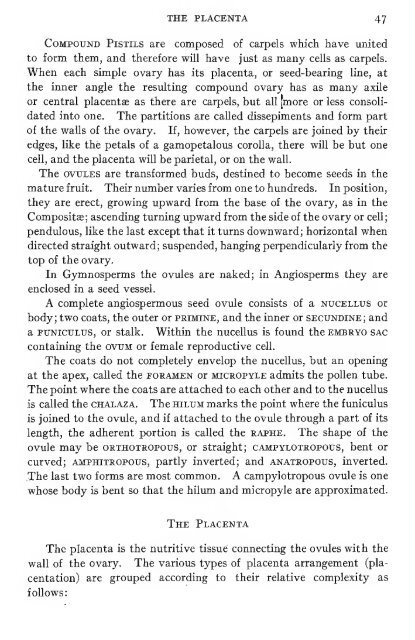Pharmaceutical botany - Lighthouse Survival Blog
Pharmaceutical botany - Lighthouse Survival Blog
Pharmaceutical botany - Lighthouse Survival Blog
Create successful ePaper yourself
Turn your PDF publications into a flip-book with our unique Google optimized e-Paper software.
THE PLACENTA 47<br />
Compound Pistils are composed of carpels which have united<br />
to form them, and therefore will have just as many cells as carpels.<br />
When each simple ovary has its placenta, or seed-bearing line, at<br />
the inner angle the resulting compound ovary has as many axile<br />
or central placentae as there are carpels, but all [more or less consoli-<br />
dated into one. The partitions are called dissepiments and form part<br />
of the walls of the ovary. If, however, the carpels are joined by their<br />
edges, like the petals of a gamopetalous corolla, there will be but one<br />
cell, and the placenta will be parietal, or on the wall.<br />
The OVULES are transformed buds, destined to become seeds in the<br />
mature fruit. Their number varies from one to hundreds. In position,<br />
they are erect, growing upward from the base of the ovary, as in the<br />
Compositce; ascending turning upward from the side of the ovary or cell;<br />
pendulous, like the last except that it turns downward; horizontal when<br />
directed straight outward; suspended, hanging perpendicularly from the<br />
top of the ovary.<br />
In Gymnosperms the ovules are naked; in Angiosperms they are<br />
enclosed in a seed vessel.<br />
A complete angiospermous seed ovule consists of a nucellus or<br />
body ; two coats, the outer or primine, and the inner or secundine ; and<br />
a FUNICULUS, or stalk. Within the nucellus is found the embryo sac<br />
containing the ovum or female reproductive cell.<br />
The coats do not completely envelop the nucellus, but an opening<br />
at the apex, called the poramen or micropyle admits the pollen tube.<br />
The point where the coats are attached to each other and to the nucellus<br />
is called the chalaza. The hilum marks the point where the funiculus<br />
is joined to the ovule, and if attached to the ovule through a part of its<br />
length, the adherent portion is called the raphe. The shape of the<br />
ovule may be orthotropous, or straight; campylotropous, bent or<br />
curved; amphitropous, partly inverted; and anatropous, inverted.<br />
The last two forms are most common. A campylotropous ovule is one<br />
whose body is bent so that the hilum and micropyle are approximated.<br />
The Placenta<br />
The placenta is the nutritive tissue connecting the ovules with the<br />
wall of the ovary. The various types of placenta arrangement (pla-<br />
centation) are grouped according to their relative complexity as<br />
follows
















